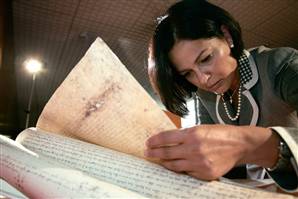
AOL - October 13, 2007
The Knights Templar, the medieval Christian military order accused of heresy and sexual misconduct, will soon be partly rehabilitated when the Vatican publishes trial documents it had closely guarded for 700 years. A reproduction of the minutes of trials against the Templars, "'Processus Contra Templarios -- Papal Inquiry into the Trial of the Templars"' is a massive work and much more than a book. "This is a milestone because it is the first time that these documents are being released by the Vatican, which gives a stamp of authority to the entire project. Nothing before this offered scholars original documents of the trials of the Templars", said Professor Barbara Frale, a medievalist at the Vatican's Secret Archives. 799 numbered copies of the work have been made.
One parchment measuring about half a meter wide by some two meters long is so detailed that it includes reproductions of stains and imperfections seen on the originals. Pope Benedict will be given the first set of the work, published by the Vatican Secret Archives in collaboration with Italy's Scrinium cultural foundation, which acted as curator and will have exclusive world distribution rights.
The Templars, whose full name was "Poor Fellow-Soldiers of Christ and of the Temple of Solomon," were founded in 1119 by knights sworn to protecting Christian pilgrims visiting the Holy Land after the Crusaders captured Jerusalem in 1099. They amassed enormous wealth and helped finance wars of some European monarchs. Legends of their hidden treasures, secret rituals and power have figured over the years in films and bestsellers such as "The Da Vinci Code." The Knights have also been portrayed as guardians of the legendary Holy Grail, the cup used by Christ at the Last Supper before his crucifixion. The Vatican expects most copies of the work to be bought up by specialized libraries at top universities and by leading medieval scholars.
The Templars went into decline after Muslims re-conquered the Holy Land at the end of the 13th century and were accused of heresy by Philip IV of France - Philip The Fair, their foremost persecutor. Their alleged offences included denying Christ and secretly worshipping idols. The most titillating part of the documents is the so-called Chinon Parchment, which contains phrases in which Pope Clement V absolves the Templars of charges of heresy, which had been the backbone of King Philip's attempts to eliminate them. Templars were burned at the stake for heresy by King Philip's agents after they made confessions that most historians believe were given under duress.
The parchment, also known as the Chinon Chart or Parchment, was "misplaced" in the Vatican archives until 2001, when Frale stumbled across it. "The parchment was catalogued incorrectly at some point in history. At first I couldn't believe my eyes. I was incredulous," she said. "This was the document that a lot of historians were looking for," the 37-year-old scholar said. Philip was heavily indebted to the Templars, who had helped him finance his wars, and getting rid of them was a convenient way of cancelling his debts, some historians say. Frale said Pope Clement was convinced that while the Templars had committed some grave sins, they were not heretics.
Their initiation ceremony is believed to have included spitting on the cross, but Frale said they justified this as a ritual of obedience in preparation for possible capture by Muslims. They were also said to have practiced sodomy. "Simply put, the pope recognized that they were not heretics but guilty of many other minor crimes -- such as abuses, violence and sinful acts within the order. But that is not the same as heresy," Frale said.
Despite his conviction that the Templars were not guilty of heresy, in 1312 Pope Clement ordered the Templars disbanded for what Frale called "the good of the Church" following his repeated clashes with the French king. Frale depicted the trials against the Templars between 1307 and 1312 as a battle of political wills between Clement and Philip, and said the document means Clement's position has to be reappraised by historians. "This will allow anyone to see what is actually in documents like these and deflate legends that are in vogue these days," she said.

Rosi Fontana, who has helped the Vatican coordinate the project, said, "The most incredible thing is that 700 years have passed and people are still fascinated by all of this. The precise reproduction of the parchments will allow scholars to study them, touch them, admire them as if they were dealing with the real thing. But even better, it means the originals will not deteriorate as fast as they would if they were constantly being viewed."
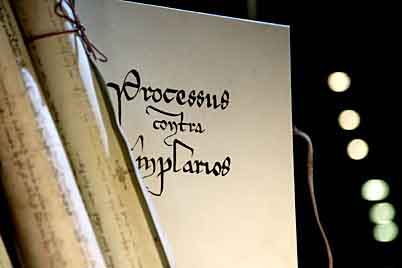
The Vatican Secret Archives is publishing 799 copies of a document
that was found in 2001 after being lost for centuries.
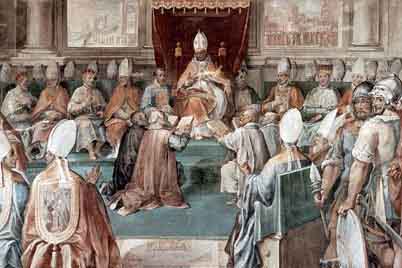
The document suggests that Pope Clement V, depicted above in a painting,
did not think the Knights were guilty of heresy, but felt pressure from
the French King and ordered the group to disband.
The photos on AOL end with connections to the bloodline ... (wink)
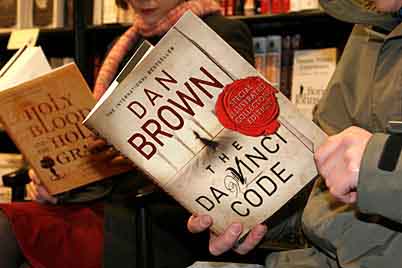
Scotsman.com - May 20, 2005
1398 and the fleet sails from Orkney on a voyage funded by the Templars to the New World. On board are Prince Henry Sinclair, Lord of Rosslyn, and the Zeno brothers, renowned Venetian sailors.
One hundred years before Christopher Columbus discovered America they reached Nova Scotia where Templar architecture and the oral history of the Mi'kmaq Indians are all that remain to inform us of this voyage. Prince Henry's death shortly after returning to Orkney meant that news of his epic journey was lost for centuries. Attempts to bring Prince Henry's exploits back to life have been renewed in recent years. Much of the credit for this lies with Niven Sinclair, an 81-year-old businessman and Sinclair clan member who says that for 30 years he has "worked solely to finance this crusade to re-write history."
To claim that a Scottish Knight Templar first landed in North America is an enormous re-write of history or it would be if there wasn't a big question mark hanging over the historical proof. "The whole thing is complete baloney from beginning to end," says Brian Smith, archivist with Shetland Islands Council, who has written papers on Prince Henry's voyage. "It makes me blush that people actually believe any of it."
The veracity of the voyage has become a battleground. In the red corner are those who want to hold up a mirror to history and re-write it, and those in the blue corner who demand greater historical accuracy. "There is so much proof that the voyage happened," insists Niven Sinclair, the red corner's biggest hitter. "Unlike Brian Smith I've walked in the footsteps of Prince Henry. I have seen tonnes of documentation and there is absolutely no doubt at all about it."
The proof for the voyage seems compelling. There is the famous Zeno Narrative, a map which purports to show the journey the brothers took with a man called Zichmni (later identified by writer John Forster as Prince Henry himself). This provided the foundation for a 19th-century book by Richard Major, a well-respected geographer who suggested Prince Henry indeed reached America.
A later book by Frederick Pohl traced the actual landing spot to Guysborough, Nova Scotia. Pohl found confirmation of the voyage by studying Mi'kmaq oral history. And there is an ancient Venetian canon, a strange carving of a knight and the Newport Tower found down the eastern seaboard from Guysborough that offer further proof.
Finally there are the carvings at Rosslyn Chapel, built near Edinburgh by the Sinclair family in 1446 and made popular by the book The Da Vinci Code, that show maize and aloe vera - plants which at that time were indigenous to North America but carved before Columbus discovered the New World in 1492. Pretty compelling stuff, and certainly enough to convince D'Elayne and Richard Coleman who run the Prince Henry Sinclair Society of North America. They read Pohl's book, met with Niven Sinclair and were converted. Richard Coleman says he is passionate about the story because he is "interested in real history, not phoney history."
So far the Colemans say they have spent $30,000 building a monument to Prince Henry in Nova Scotia. They are also hoping to build a national park in his memory. Ranged against them in the blue corner is Smith, the Shetland archivist who has had some robust run-ins with Niven Sinclair. Smith argues that the Newport Tower is a fully documented 17th-century tower, that the knight is even later, and argues there is more than enough evidence to prove "without a shadow of doubt that the Zeno Narrative was written in the 16th century."
And as for the maize and the aloe vera?
"You mean the wheat and the strawberries?" chides Mark Oxbrow, a Fellow of the Antiquarian Society who is writing a book about Rosslyn. Oxbrow has become increasingly concerned with the high profile the Prince Henry voyage is enjoying. More generally he is worried about stories linking the Sinclairs with the Templars. "The problem today is that very little is actually historical," he says. "And the more publicised it gets, the more loopy it gets too."
The "loopiness" that Oxbrow is referring to is the staggering number of people who believe the Sinclairs are, variously: the keepers of the Ark of the Covenant and/or the Holy Grail, voyagers to America and descendants of Jesus Christ himself. Niven Sinclair certainly believes that the blood of Jesus runs through his veins and that the history of the Sinclairs is an incredibly one. "You can't be anything but humbled by being a Sinclair," he enthuses. This claim to greatness on behalf of the Sinclair clan is not supported universally. Robert Cooper, curator to the Grand Lodge of Scotland, has looked into the genealogy of the Sinclairs.
"Until recently the Sinclairs were not an important family," Cooper says. "Look at the back of any history book and they don't have many references." Cooper gets irate when he is told that Rosslyn is a Templar church and that the Sinclairs grew rich from Templar money. He cites as an example the fact a Sinclair testified against the Templars at their Scottish trials.
So just why are a hitherto nondescript Scottish family now at the forefront of so much speculative revisionist history? Smith thinks he knows the answer. "I always say that there is only one book that anyone needs to read," Smith says, "and that is Niven Sinclair's cheque book." By his own admission, Niven Sinclair has spent a lot of money on the Prince Henry project. "I can't tell you how much I've spent because I would have the tax man chasing me," he confirms, "but I work in order to finance this." Developing this new Sinclair legend may be a jolly good wheeze, but Smith says it compromises our known history in favour of a flamboyant version. "You can't just make up the past," Smith insists.
AP - April 6, 2004
One of the strangest archaeological artefacts I ever saw is housed at a secret address in Kilbarchan. It's the stone head of a black-skinned, pre-Christian goddess which surfaced near the majestic West Church in the picturesque Renfrewshire village. Although the beautiful red sandstone kirk is just over a century old, it occupies the site of the pre-Reformation St Catherine's Chapel.
Equally enigmatic - and carved on an ancient stone wall surrounding the snowdrop- silvered tombstones in the graveyard - is the sword of a Knight Templar thought to be a member of the Craufurd family, of nearby Auchenames Castle, who served in the 12th and 13th century Crusades to regain the Holy City of Jerusalem for Christendom.
The sculpted sword - which signifies a Templar burial sepulchre - and the wizened stone head are inextricably linked. After 200 years of valiant Christian service, the Templars were brutally suppressed between 1307 and 1314 by an unholy alliance of the Church and French king Philippe IV. Their political and ecclesiastical masters believed the Knights were too powerful and wealthy. So they accused the brave brotherhood of heretical religious observances, including the worship of enchanted human heads.
At an Inquisition in 1308, the Knights Templar were accused of 'having idols, namely heads, that they adored these idols, said they could save them, and that the heads could create riches, make trees, flower and land germinate'.
It was believed the sculpted heads were inspired by the dark-skinned Egyptian Goddess, Isis, consort of Osiris, the dying-and- resurrecting vegetational god, and mother of Horus, who was the reborn Osiris and identifiable with the Egyptian Pharaohs.
It was alleged the Templars were introduced to the Isis Earth Mother cult, with its promise of resurrection after death in battle, during the Crusades. Perhaps the mysterious stone head was brought to Renfrewshire from the Holy Land by a Knight Templar - possibly a Craufurd of Auchenames - commemorated by the sculpted sword at the village's medieval graveyard. Today, the fields and woods around the elegant church in Kilbarchan are fragrantly- floriated by springtime daffodil, crocus, cherry, celandine and coltsfoot blossoms. It seems the sacred stone head still makes trees flower in the luxuriant land where an entombed Knight Templar awaits the trumpet call of resurrection in the Earth Mother's bosom.
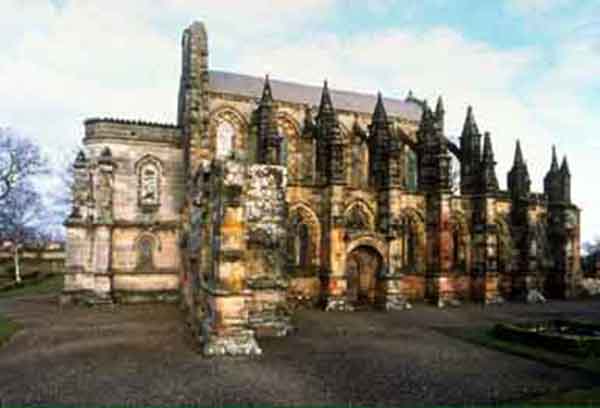
January 6, 2003 - Independent.co.uk
For centuries the intricately carved stones of Rosslyn Chapel near Edinburgh have tantalised historians, archaeologists and devoted Christians. A labyrinth of vaults beneath the 15th-century home of the Knights Templar is reputed to contain dozens of holy relics, including early gospels, the Ark of the Covenant, and the fabled Holy Grail.
More than 550 years after the first foundation stones were laid, modern technology is about to put the legend to the test. A group of Knights Templar, successors to the warrior monks who sought asylum from the Pope by fleeing to Scotland in the early 14th century and fought for Robert the Bruce at Bannockburn, are to make a "non-invasive" survey of the land around the chapel. They will use the latest ultrasound and thermal imaging technology in the hope of finding evidence of the existence of the vaults.
"The plan is to investigate the land around the chapel to a depth of at least 20ft," said John Ritchie, Grand Herald and spokesman for the Knights Templar. "The machine we are using is the most sophisticated anywhere and is capable of taking readings from the ground up to a mile deep without disturbing any of the land.
"We know many of the Knights are buried in the grounds and there are many references to buried vaults, which we hope this project will finally uncover." Rosslyn Chapel, or the Collegiate Chapel of St Matthew as it was to have been, was founded in 1446 by Sir William St Clair, third and last Prince of Orkney. Built as a celebration of Christ, it is also a monument to craftsmanship.
Bristling with flying buttresses and gargoyles in the highest Gothic style on the outside, the interior is carved with scenes from the Bible, the fall of man, the expulsion from the Garden of Eden, the birth of Christ, the crucifixion and the resurrection.
"Rosslyn is an amazing building. It is a book in stone but, because the symbolism which is written into the chapel is in a medieval language, we haven't even cracked the introduction page yet," Mr Ritchie said.
Pillars and arches are covered with hundreds of exquisitely carved leaves, fruit, animals and figures. Some curious carvings are said to depict cactus and sweetcorn, chiselled before Columbus set foot in America in 1492.
"There is a whole series of stuff on each section of the chapel, which relates to a different period of time," Mr Ritchie added. "We have to go back to the 15th century and read it with a medieval eye to understand what it all means. All these symbols relate to events in history. It is a book created in stone, which brings in all the apostolic religion, laid over by an astrological form which tracks the seasons, and the plants in the seasons." Both the Freemasons and the Knights Templar claim the ornate stonemasonry of the church is a secret code which, if broken, will reveal the whereabouts of treasures.
One theory suggests that one of the ornate columns, known as the Apprentice Pillar, may contain a lead casket in which is hidden the legendary cup used by Christ at the Last Supper and later used to collect his blood, the so-called Holy Grail. "Once we understand the introduction page we will begin to understand what this book in stone means," Mr Ritchie added. "We hope to start as soon as possible and get a load of readings from it. We hope to at least find this burial place and maybe the Holy Grail itself."
MYSTERY SCHOOLS & SECRET SOCIETIES
CRYSTALINKS MAILING LIST, NEWSLETTER, UPDATES
ALPHABETICAL INDEX OF ALL FILES